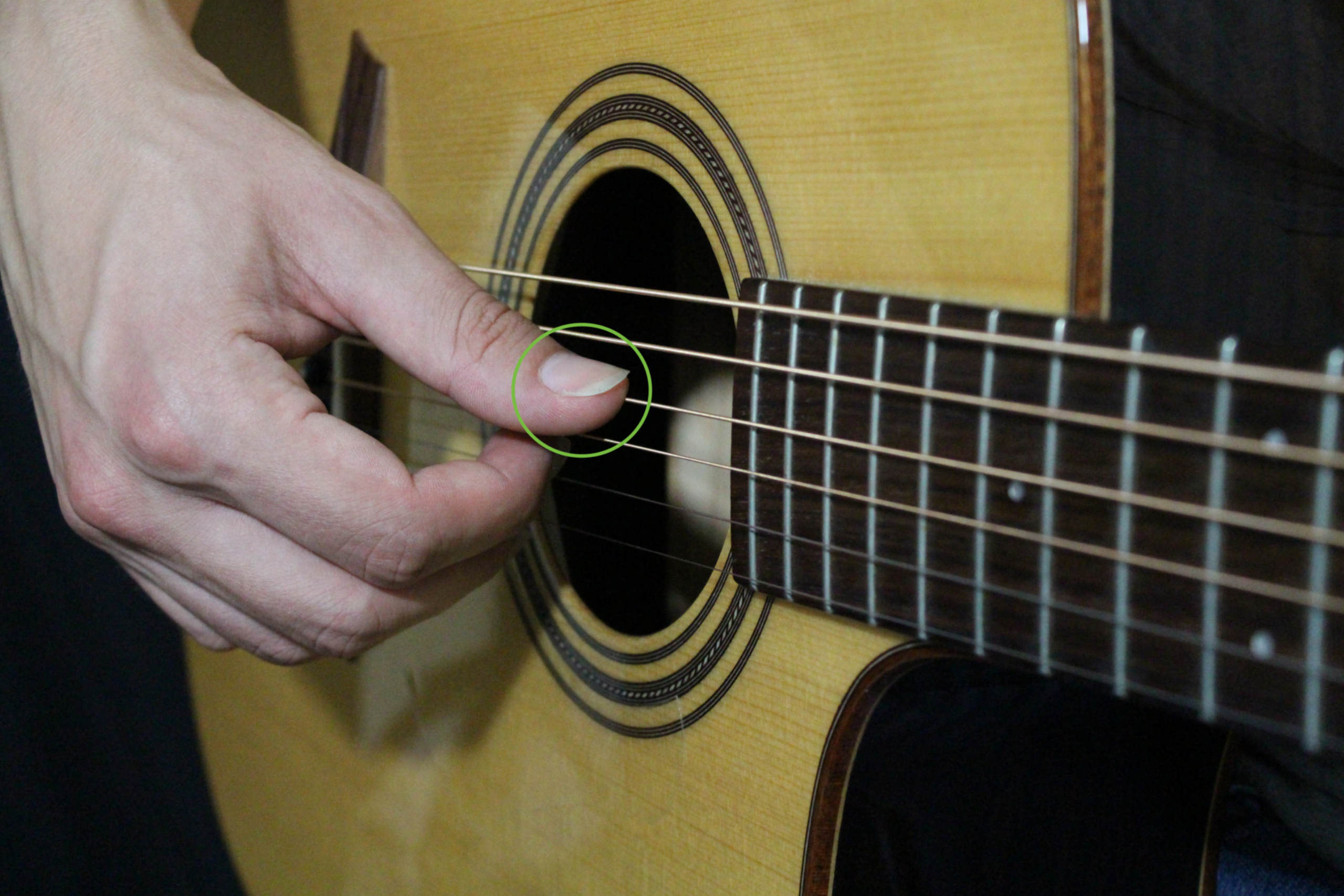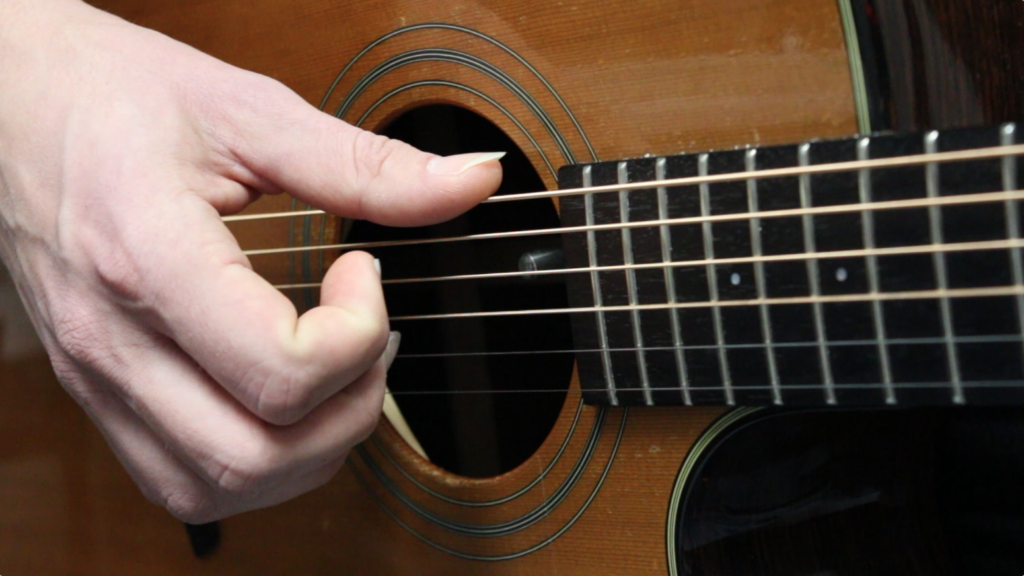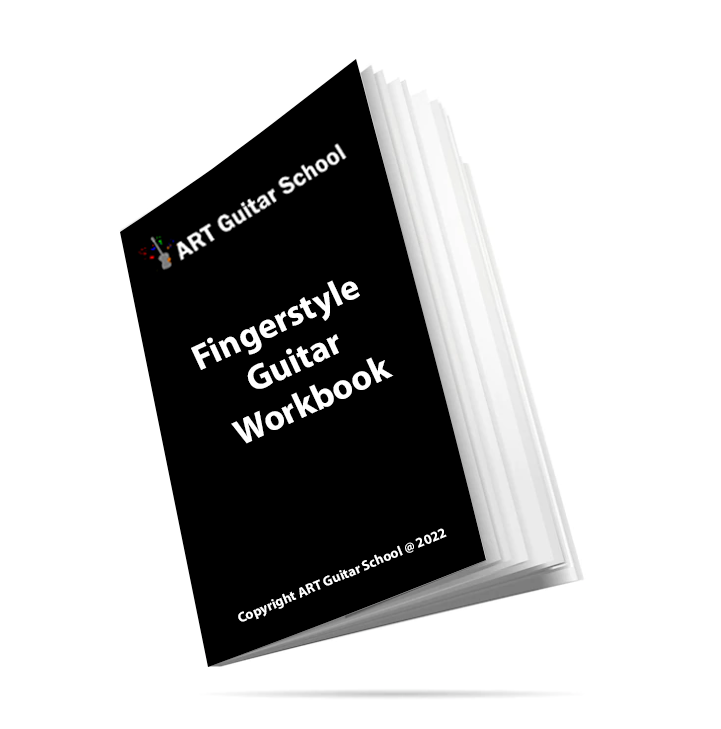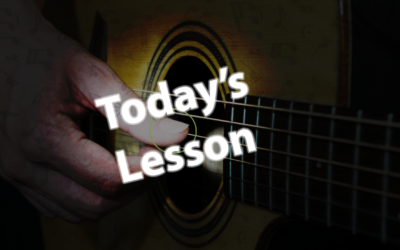It’s essential to have the correct RH technique in order to improve in your playing. First we must focus on the right hand and the proper technique associated with it.
Having proper technique will make playing much easier and allow you to play more challenging repertoire and exercises.
Fingers and Strings
Thumb should be on the sixth, fifth, and fourth strings while the index middle ring will be on the third, second and first strings.
P = 6, 5, 4
I = 3
M = 2
A = 1
Right hand positioning
The right hand should be hovering over the sound hole in the middle. You can also place it back slightly as well for a different timbre. Make sure the right hand is relaxed while hanging over the strings.

Attack motion
The attack should be a motion of the fingers coming in towards the palm. Prevent yourself from plucking up, or a clawing attack, which will cause the strings to be bright and thin.
Here is a video on beginner finger picking patterns I recommend:
Practice this with your own songs, or solely to work on your technique in order to improve your playing.
Learn more about technique through our FREE Fingerstyle Workbook!
FOLLOW US ON
Get our FREE Fingerstyle Workbook!
RELATED BLOG POSTS
How to Build Finger Strength and Dexterity
Building finger strength and dexterity is essential for any guitarist, especially those focusing on fingerstyle techniques. Here are some effective exercises to enhance your finger agility and power.
Start with simple finger exercises such as scales and arpeggios. Practicing these regularly not only strengthens your fingers but also improves your overall technique. Focus on playing each note cleanly and evenly, gradually increasing your speed.
Another effective exercise involves finger independence drills. Place your fingers on the fretboard, and lift them one at a time while keeping the others pressed down. This helps develop control and coordination, crucial for intricate fingerstyle patterns.
Incorporate the use of a hand grip or rubber band to strengthen your fingers. Squeeze the grip or stretch the band with your fingers to build muscle. Regular practice will lead to noticeable improvements in finger strength.
Lastly, don’t overlook the importance of proper warm-up routines. Before diving into practice, spend a few minutes warming up your fingers with simple exercises. This prepares your muscles and prevents injuries.
Building finger strength and dexterity takes time, so be patient and consistent. With dedication, you’ll notice significant improvements in your fingerstyle playing, allowing you to tackle more complex pieces with ease.
The Importance of Nail Care for Fingerstyle Guitarists
For fingerstyle guitarists, nail care is crucial. Healthy nails not only enhance your playing but also improve your overall sound quality. Here’s a guide to help you maintain your nails for optimal fingerstyle performance.
Firstly, keep your nails at an appropriate length. Short nails may not provide enough surface area for plucking, while overly long nails can hinder your playing. Aim for a length that feels comfortable and allows for precise control.
Regular filing is essential to prevent snags and breaks. Use a fine-grit nail file and smooth out any rough edges. Consider shaping your nails into a slightly rounded or pointed form, as this can facilitate better tone production and allow for clearer articulation of notes.
Moisturizing is another vital aspect of nail care. Apply a nourishing cuticle oil or hand cream to prevent dryness, which can lead to brittle nails. Hydrated nails are less prone to breaking and will perform better during play.
If you prefer to use artificial nails, choose high-quality materials that mimic the sound of natural nails. Practice adjusting your technique to accommodate the different feel and sound.
Remember, well-cared-for nails can greatly enhance your fingerstyle guitar sound. Prioritize your nail care routine to enjoy a more enjoyable and expressive playing experience.
Advanced Fingerstyle Techniques: Harmonics and Tapping
Once you’ve mastered basic fingerpicking, it’s time to explore advanced techniques like harmonics and tapping. These methods can significantly enhance your fingerstyle guitar playing, adding depth and complexity to your sound.
Harmonics are produced by lightly touching the string at certain points, creating a bell-like tone. To achieve this, place your finger directly above the fret wire (not in between) and pluck the string with your other hand. Start with natural harmonics on the 5th, 7th, and 12th frets, as these are the most accessible.
Incorporating tapping into your fingerstyle repertoire can create an exciting and dynamic sound. This technique involves using your fingers to tap notes on the fretboard, allowing for rapid note sequences and melodic lines. Begin by practicing a simple tapping exercise: tap the 12th fret with your right-hand fingers while maintaining a consistent rhythm with your left-hand notes.
Combining these techniques can produce intricate melodies and rhythms. Try integrating harmonics into your tapping sequences for a unique sound that captivates your audience. Practice slowly and gradually increase your speed, ensuring clarity in each note.
Remember to be patient with yourself as you learn these advanced techniques. With practice, harmonics and tapping can become signature elements in your fingerstyle playing, setting you apart as a guitarist.






0 Comments